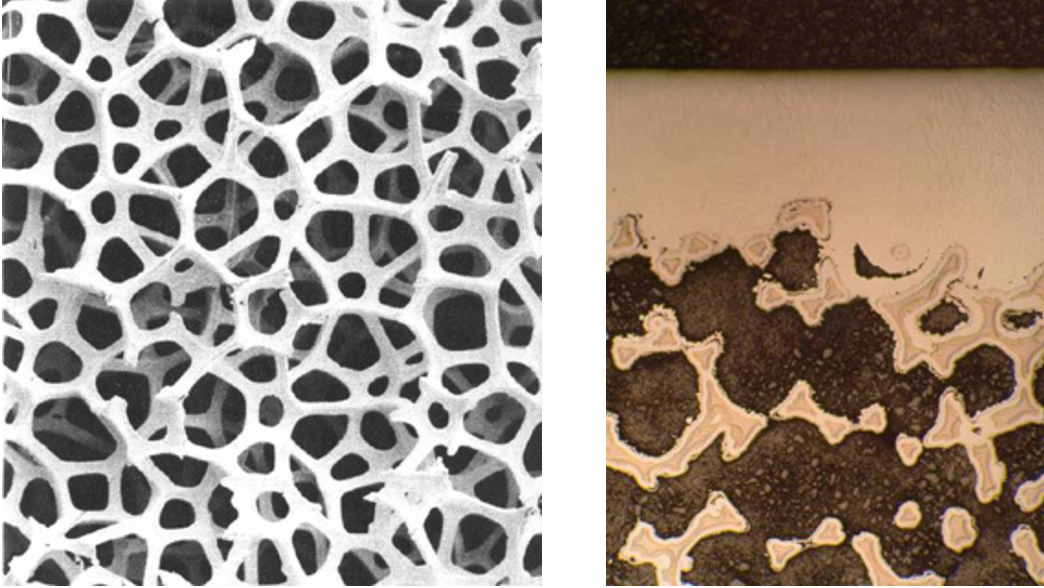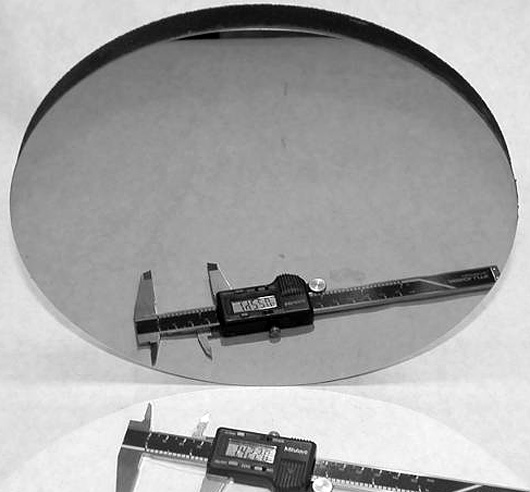Mirrors
Foam-core sandwich panels offer exceptional stiffness-to-weight ratios, and Ultramet has used this architecture for advanced mirror systems. Foam-core mirrors employ an optical faceplate that is attached to the surface of a foam billet, and, if stiffness requirements demand, a second faceplate can be added to the rear surface. Mirrors have been fabricated with both flat and curved optical surfaces, and several material systems have been used. Silicon and silicon carbide systems offer the greatest stiffness-to-weight ratio.
Advantages
- Optical properties meet or exceed those of current glass, ceramic, and metal reflectors while maintaining a substantially lower areal density.
- Foam structural support yields high specific strength and low mass.
- Fully dense, isotropic, near-net-shape faceplate is highly polishable.
- Thermal conductivity is high.
- Fluids can be passed through foam for actively cooled structures.
- Less complex and less expensive positioning systems are required.
Silicon Carbide
Ultramet combines a precision silicon carbide reflector surface and a high specific strength, low-mass silicon carbide structural support to fabricate optical composite reflectors for space- and Earth-based telescopes.

Left, low-density, high-stiffness silicon carbide foam structural support (50×); right,cross-section of silicon carbide mirror surface (top) applied over silicon carbide foam (bottom).

Silicon carbide foam-based mirror, 10″ diameter, after polishing
Silicon
Elemental silicon is an excellent mirror material given its outstanding polishability and, as can be seen in the following table, its extremely low density and outstanding stiffness-to-weight ratio. Silicon can be single-point diamond turned and can be polished to an arbitrarily small surface root-mean-square.
| Sic | Si | Al | Be | Cu | Ni | ULE silica | Cervit | Zerodurv | |
|---|---|---|---|---|---|---|---|---|---|
| Density, kg/m 3 x10-3 | 3.21 | 2.33 | 2.7 | 1.85 | 8.92 | 8.9 | 2.2 | 2.5 | 2.55 |
| Thermal Expansion coeffecient, 1/k x 10-6 RT to 100C |
4.0 | 3.7 | 25 | 12 | 16.6 | 13 | 0.03 | 0.12 | 0.15 |
| Thermal Conductivity W/m-K |
150 | 130 | 237 | 218 | 398 | 90 | 1.3 | 1.5 | 6.0 |
| Specific heat, J/KG+ K | 700 | 710 | 899 | 1880 | 380 | 440 | 708 | – | 820 |
| Elastic modulus, GPa | 466 | 155 | 69 | 285 | 177 | 207 | 67 | 105 | 90 |
| Inertia Loading paramater, kg/N – mX10-8 | 0.69 | 1.5 | 3.91 | 0.65 | 7.62 | 4.3 | 3.28 | 2.38 | 2.83 |
| Thermal Distortion Parameter, W/m x 10 7 | 2.7 | 2.85 | 10.5 | 5.5 | 4.17 | 14.4 | 2.31 | 8.0 | 2.5 |
Silicon foam mirrors have excellent thermal stability and show minimal distortion because silicon has outstanding thermal conductivity. Zygo measurements indicate a root-mean-square roughness of only 0.094 waves.

Zygo plot of foam core silicon mirror at −178º
